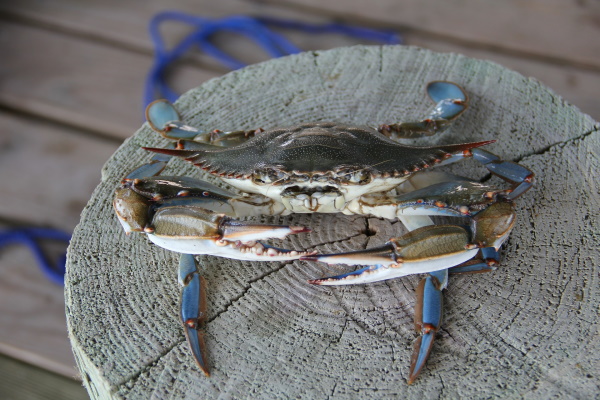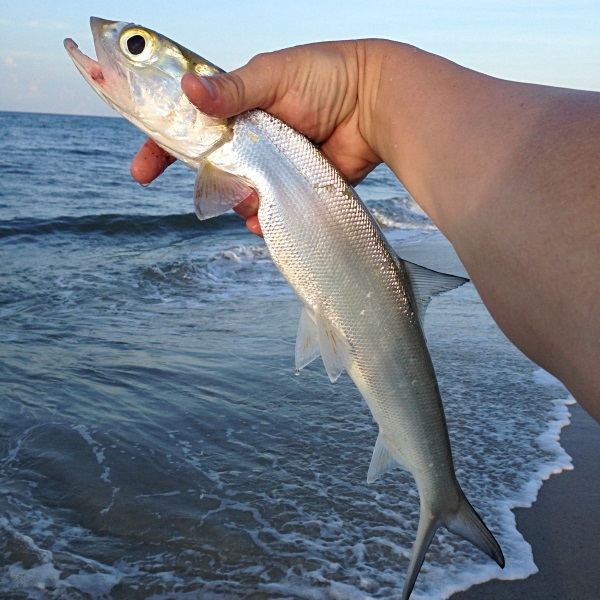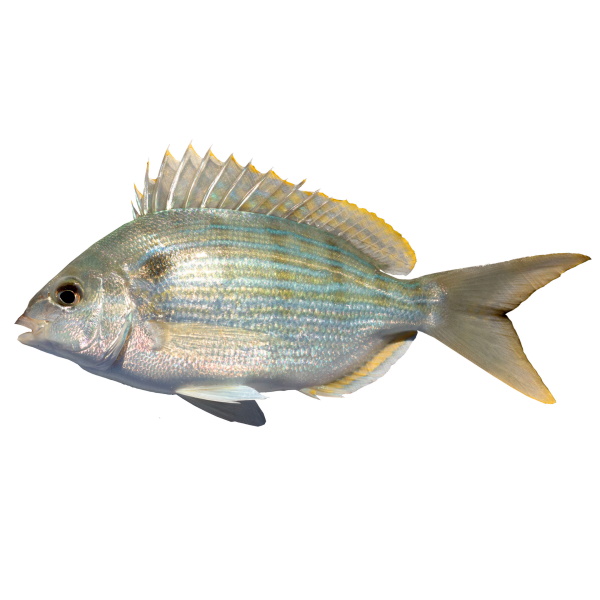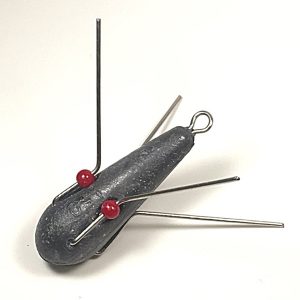The best bull red baits are probably blue crab and mullet, but that might vary depending on where you’re fishing.
Below is a list of all the top bull redfish baits, along with their common names, where to get them, and how to use them.
A specific bait could go by a totally different name, depending on region. I find it helpful to list the actual scientific name, along with all their common names. With that bit of info, you’ll know exactly what people are referring to when they say use this certain bait, or that one.
1. Blue Crab
(Callinectes sapidus)
Other Names
Chesapeake Blue Crab

Blue crabs are possibly a bull redfish’s favorite meal. If you’ve never used large crabs as bait, it might seem intimidating at first. I inserted a video below with some good rigging advice for live blue crabs. Cutting them in half works great as well. Be careful when using crabs, because those claws can hurt you if you don’t grasp the crab properly.
Where To Get Blue Crabs
Blue crabs can either be purchased live from bait shops, or they can be trapped using crab traps, among other methods.
Rigging Blue Crabs
The first thing you want to do is get rid of the pinching claws. At that point, you can keep the crab intact, or you could cut the crab in half for two baits. Cutting it in half will release a ton of scent into the water. That would certainly be good, but we’re after bulls, so a bigger bait is usually better.
Keep The Crab Intact
Keeping the whole crab intact will ward off a lot of smaller fish from getting hooked, and it will keep small fish from picking the carcass clean.
While it might seem impossible for a fish to eat a big crab with the top shell on, I can assure you that a bull red will have no problem taking in a whole blue crab. They have crushers in their throat that will make easy work of eating a large crab.
Hooking It
When fishing with a whole blue crab, break off a few legs to release scent into the water. Then, use a 5/0 to 9/0 sized circle hook, and insert it into one of the leg holes and back out either the top or the bottom of the crab.
2. Mullet
(Mugil cephalus)
Other Names
- Striped Mullet
- Sea Mullet (“sea mullet” is also a commonly used name for whiting)
- Black Mullet
- Finger Mullet (just refers to small sized mullet)
- Cobb Mullet (just refers to mid-sized mullet)

Mullet have to be a top 2 bait for redfish. They can be found all through the Gulf and along the Atlantic coast. If you live along the Atlantic, where the annual mullet migration occurs, count yourself lucky. Mullet makes a fantastic and durable bait for reds.
Finger Mullet
Finger mullet is simply a reference to small sized mullet. Small mullet can be fished live by hooking through either their lips or through their back, just below the dorsal fin.
Cobb Mullet
The definition of a “cobb mullet” seems rather arbitrary. We’ll call it longer than your hand, but less than a pound. Somewhere in that size range is what’s called a cobb mullet. I suppose they probably termed it as such, based on their size compared to a corn cob. That’s just a guess though.
Where To Get Mullet
Frozen mullet can be purchased from bait shops, or you can cast net your own live mullet. At times, some bait shops even offer fresh dead mullet, which would be a good option. Remember, fresh is always preferred over frozen. You would be well served to go out of your way to get fresh mullet, if at all possible.
How To Use Mullet For Redfish Bait
Small live mullet can be fished with a hook through the lips, or in the top of the back. More commonly, you would cut a mullet into chunks about half the size of your palm or bigger. Mullet heads also make terrific baits for bull reds.
3. Menhaden
(Brevoortia tyrannus)
Other Names
- Pogy
- Bunker
- Mossbunker
- Pogies
- Peanut Bunker (simply refers to the size of a small menhaden)
- Atlantic Menhaden

Menhaden, pogy, and bunker are all the same fish. They are a very oily fish that makes a great bait for larger species. Unfortunately, they are fragile, hard to keep alive, and do not freeze well. Fresh caught menhaden is certainly a top bait for bull reds.
Where To Get Bunker
Frozen bunker, or pogies, can be purchased from bait shops, however fresh is always better. To obtain fresh bunker, you can either cast net them, or you can use a snag hook to pick them off from passing schools in the surf. Schools of pogies will often flip on top of the water which will help give away their location. You can also look for birds, particularly diving pelicans, that will give them away.
How To Use Them
You can use the whole head by cutting straight through, right behind the fin. Then, just cut the rest of the fish into sizable chunks at least 2 inches long. The larger pieces will help keep smaller fish off your hook.
For heads, run the hook through the tip of the lips, but don’t hook it too deep. For chunks, either run your hook into the meaty part and then back out through the skin, or insert it cross ways through the belly or back. Either way you hook them, it’s very important to not over choke the hook with bait. You should have a good section of the hook point exposed.
4. Ladyfish
(Elops saurus)
Other Names
- Skipjack
- Ten Pounder
- Poor Man’s Tarpon
- Banana Fish

Ladyfish are one of my favorite baits for catching large fish from the beach. They’re bloody, oily and easy to catch. They’re simply one of the best free baits for bull drum that you’ll find.
Where To Get Them
If ladyfish are around, they’re super easy to catch. I catch them on baited pompano rigs, spoons, jerkbaits and hair jigs. Pretty much anything that mimics a small silvery fish will work.
I have an entire article on how to catch Ladyfish here if you are interested – How To Catch Ladyfish
How To Use Them
Simply slice ladyfish straight through the body into 2-4” chunks, and run a 5/0-9/0 circle hook through them. As with any cut bait, be sure not to over choke the hook. Don’t throw the head away as it works great as well. One average sized ladyfish will provide 3 or 5 good baits.
5. Spot
(Leiostomus xanthurus)
Other Names
- Spot Croaker
- Norfolk Spot
- Striper Candy
Another proven bait for bull reds is spot croaker. Spots are a small sized member of the croaker family of fishes. Although their primary range is from the Chesapeake Bay southward to the Carolinas, they can also be found all the way to Florida and throughout the Gulf.
Spots look very similar to a Atlantic croaker, but they have a tell tale black spot just behind the gills as well as a forked tail. Most are well under a pound and 6-8″ long, but they can get to over 12″.
Where To Get Spot
It is sometimes possible to purchase spots in bait shops, but you are better off catching them yourself. Spots have very small mouths, so use really small cut baits, squid, or bloodworms on small hooks to catch them from the surf.
How To Use Them
Depending on size, either fish them whole, or cut them in half for two baits. If fishing them live, cut off the fins, and run the hook sideways through the nose.
6. Pinfish
(Lagodon rhomboides)
Other Names
- Pins
- Pinners

Pinfish are a plentiful and very durable bait fish. Because they are so durable, pins are very easy to keep lively and fresh. As we know, fresh is best! Much like a whiting, a pinfish is not necessarily the top choice, but if it’s what you have, or what you can get, it’s a great choice. Bull reds will 100% eat a pinfish.
How To Catch Pinfish
There are many effective ways to catch pinfish. You can use a pinfish trap, a castnet, a sabiki, or just a small hook and line to catch pinfish.
To collect pinfish, find a sandy spot near some grass, and chum some pinfish up for your castnet. Or, you can place your baited pinfish trap in a sandy spot surrounded by grass. Wait for 45 minutes to overnight, and you should have some lively pins for bait. Either way, grass is key.
You can also catch pinfish using hook and line around pier and bridge pilings.
How To Rig Pinfish For Bull Reds
Bigger pinfish are a great size for bull red baits. Fish them live by cutting the fins off, and inserting a hook through the top of the back, right near the end of the dorsal fin. Or, if you have a really big one, you can cut it in half for 2 baits.
7. Whiting
Menticirrhus littoralis (Gulf), Menticirrhus americanus (Southern), Menticirrhus saxatilis (Northern)
Other Names
- Gulf Kingfish
- Southern Kingfish
- Northern Kingfish
- Southern Kingcroaker
- Northern Kingcroaker
- Kingfish
- Sea Mullet (“sea mullet” is also a commonly used name for actual mullet)
- Roundhead
- Virginia Mullet

Whiting are another one of those fish with a lot of different regional names, which makes it very confusing to know what anglers are talking about. Hopefully the list of names above clears some of that up.
Although whiting are not necessarily at the top of anyone’s list, they do work well as cut bait. They are typically very plentiful in the surf, so if you’re fishing from the beach, this is a great option. The 1-2 punch of ladyfish and whiting can keep you in good bait all day on the beach.
Where To Get Them
If you’re in an area where they are, whiting are extremely easy to catch from the edge of the surf. Use small #1 or 1/0 hooks, and small pieces of peeled shrimp, fishbites, sandfleas or any number of other small baits to catch them. Sometimes they’ll be just a few feet from the waters edge.
I have an entire article on how to catch whiting here – How To Catch Whiting aka Kingfish
How To Use Them
Small whiting can be used whole and live. Cut the fins off and hook them through the lips. Or, you can cut them up for fresh cut bait, similar to how you would any similar sized fish. I would probably cut one, like the size pictured above, into 2 baits when fishing for bulls. Larger whiting can be divided into 3 or more baits, with the head being your first bait choice.
8. Croaker
(Micropogonias undulatus)
Other Names
- Atlantic Croaker
A croaker is a solid game fish in his own right, but they also make great bait for their larger cousins, the red drum. They range all along the Atlantic and throughout the Gulf Coast, and are generally pretty easy to catch from the beach. Add these to the list of fish that can keep you in bait all day when fishing for bull reds from the beach.
How To Catch Croaker
Croaker can easily be caught from the surf using small hooks and small pieces of bait, such as shrimp, fiddler crabs, clam, sand fleas or squid. You can also cast net them.
How To Use Croaker As Bait
Big ones can be chunked up similar to the other cut bait options. Small live ones can be fished whole. Simply run a circle hook through the lips or the eyes. Big reds love small live croakers.
9. Sand Trout
(Cynoscion arenarius)
Other Names
- Sand Seatrout
- White Trout

Sand seatrout are like a small speckled trout, but with no spots. They are actually a pretty tasty fish, similar in quality to a speckled trout. Sand trout are readily available along the northern Gulf.
They have fragile flesh, so if you plan to use them later, you’ll need to chill them down quickly so that they don’t get too mushy.
Most will be under 1lb.
To loosely quote a random guy on a message board, “Sand trout, croaker, whiting, pinfish, and spot all work good, but you won’t always be able to pick which one you catch.” In other words, just use whichever one you can catch, as bull red drum like them all.
How To Catch Sand Trout
Sand Seatrout are bottom feeders, so use a small piece of cut bait on a small hook bottom rig. If they are around, they are easy to catch by using hook and line.
How To Rig Them
Rig them similar to how you do other cut baits. Small ones can be fished live.
Other Baits
Just to name a few, some other good bait options are tuna belly, live shrimp, and chunked bluefish or bluefish heads.
Conclusion
All the bull red baits listed above are proven producers. Just be sure to follow all local laws related to any species listed here. One takeaway you should have is that bull reds are not usually super picky, so use whatever you can get, as long as it’s fresh.
Now, go catch a big one!
Augustus Clay



